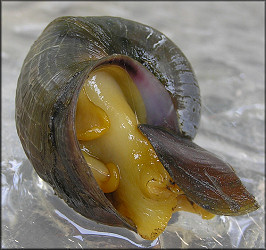|
Pomacea canaliculata (Lamarck, 1822) At St. Augustine Road Fish Management Area |
|
|
Upon arrival at the northeast end of the larger of the two lakes (GPS: 30.16167N 081.38340W), a limited number of fresh Pomacea canaliculata (Lamarck, 1822) egg clutches were seen on bank vegetation followed shortly thereafter by the find of one live Pomacea canaliculata and one empty shell. The lake was then circumnavigated but the only evidence seen of the snails was a total of about a dozen egg clutches and a further mating pair of specimens - all found in the northeast end of the lake. No evidence of the snails was found other than in this one relatively small area. The adjacent much smaller two acre lake was then investigated but no evidence of Channeled Apple Snails was seen. Based upon the limited number of Pomacea egg clutches present, as well as their location, it would appear that the Channeled Applesnail population of the lake is small and probably confined to a single area of the lake. Impoundment Map Between the initial visit and August 5th numerous additional visits were made to the lake. Cumulatively, only eight Pomacea specimens could be found (six living adults and two empty juvenile shells). All of the shells, as well as the modest number of egg clutches seen, were found on the northeast sector of the lake. No evidence of Pomacea was seen in any other area. |
|
|
[Click on the images for a higher resolution version.] |
|
| North end of the lake looking south | Living Pomacea canaliculata female specimen |
|
South end of the lake looking north |
Living Pomacea canaliculata male specimen |
 Acting on hunch, on May 2, 2007 this
reporter visited two lakes at the St. Augustine Road Fish Management
area to investigate the possibility that invasive Channeled
Applesnails might be present in the impoundments. The two lakes
involved, one of two acres surface area and another of ten, are part
of what is termed the Jacksonville Urban Pond Project (JUPP) which
is a cooperative effort between the Florida Fish and Wildlife
Conservation Commission, Jacksonville Department of Parks and
Recreation and the U. S. Fish and Wildlife Service to provide
extensive bank angling opportunities to local citizens. The two
lakes are located north of University Boulevard, west of St.
Augustine Road and are reached via Stetson Road. One other JUPP lake
in the county (
Acting on hunch, on May 2, 2007 this
reporter visited two lakes at the St. Augustine Road Fish Management
area to investigate the possibility that invasive Channeled
Applesnails might be present in the impoundments. The two lakes
involved, one of two acres surface area and another of ten, are part
of what is termed the Jacksonville Urban Pond Project (JUPP) which
is a cooperative effort between the Florida Fish and Wildlife
Conservation Commission, Jacksonville Department of Parks and
Recreation and the U. S. Fish and Wildlife Service to provide
extensive bank angling opportunities to local citizens. The two
lakes are located north of University Boulevard, west of St.
Augustine Road and are reached via Stetson Road. One other JUPP lake
in the county (


